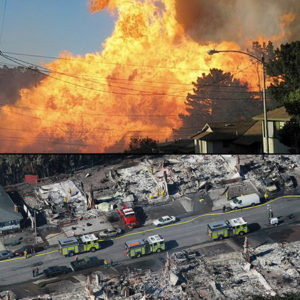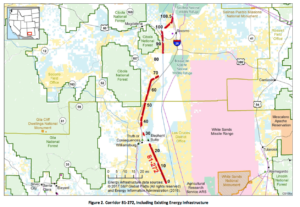Interstate Pipelines Pose a Threat to the Drinking Water Supply for the Upper Middle Rio Grande Basin
Pipelines Under the Rio
These interstate and intrastate transmission pipelines in Sandoval County have been designated High Consequence Area (HCA) pipelines by PHMSA, meaning the threat of rupture and

an explosion is high, which would decimate the aquifer, drinking water supply, risk destroying property and cause physical harm and death throughout the County. The County Commission can pass several types of ordinances that protect citizens, property, and resources. However, at the last County meeting during the discussion items, the Commissioners appeared to unknowledgeable of solutions that they could legislate and support at the County level. We have some SandCO Recommended Comprehensive Plan Language -march2018 for them if they will listen.
State and Federal level legislation are needed and we have recommendations as to what that could be as we move forward.
FAQ’S
- 5 PIPELINES: OVER 60 YEARS OLD KINDER MORGAN CO2 line ( proposing additional hydrogen line (1), MARATHON CORP (WAS TESORO CORP) ( was Western Refining) gasoline (1), ENTERPRISE (MIDAMERICAN PIPELINE WHO OWNS THREE OF THE LINES) CONTAIN: jet fuel, gasoline, diesel fuel, crude oil, natural gas liquid,ethane, propane, butane, natural gas, and carbon dioxide
- FLOW RATES: HIGH-LEVEL RATES FROM 60,000 BBL/DAY TO 175,000 BBL/DAY CARRYING 42 GALLONS PER BBL WITH PIPE DIAMETERS OF 8-16 INCHES
Placitas and East Mountains Community Threat
Demographics: “To be affected”
- I. over 6,000 residential homes and many doubled as businesses.
- II. Elementary School abt. 100 feet away from the pipeline
- III. Senior/Community Center with a pipeline running directly into the path of building and parking.
- IV. Las Huertas de San Antonio Land Grant office less than 100 feet away.
- V. Las Huertas Creek (acequia) water right grant (pipeline directly passing in and out through the creek).
- VI. Water Basin – Supplies water to 2 Pueblo’s and to Albuquerque (largest urban City in New Mexico).
- Placitas Pipeline Exposure Presentation Powerpoint with Newsreel on Pipeline exposures
- Presentation Pipelines FAQ sheet Pipeline faqs in Placitas
- Engineering Reports on exposures of High Consequence Areas (HCAs)
- 2011_engineering_report_pipeline_protections
UPDATE
- IM risk assessment on Pipeline PIR Impacts
- Mitigation plans and an assessment on the NM PRC intrastate
- Risk assessment for the impact of moving school, senior center vs. moving the southern route of the Pipeline. ($ est $60M) With the closure of existing pipeline to reroute for Safety reasons.
- BLM RMP
- Apply for funding for LEPC for State
- Apply for Funding for flooding Mitigation (USACE Community plan Dept) through USACE
- Apply for funding for Watershed Coalition to integrate planning efforts BOR.
_____________________________________________________________________________
Threats to Pueblos and Communities that the Interstate Transmission Pipelines Cross

Courtesy Democracy Now
Pipelines like the Dakota Access Pipeline are not only a danger to the environment, but they trample indigenous rights.
Fracking, Pipelines and Coal Projects Trample Indigenous Rights
Indigenous rights and environment affected when pipelines constructed
Indian communities were dismayed when President Donald Trump signed executive orders restarting construction of the Dakota Access Pipeline and the Keystone XL pipeline. Indian communities and environmentalists opposed both projects pointing out that sacred lands were jeopardized, as well as drinking water, treaty and indigenous rights.
The administration says it will renegotiate parts of the pipeline projects to conform better to Indian interests. However, one usually negotiates before making the key decision like moving a project forward. The two pipelines are similar to many projects that Indigenous Peoples want to have a voice in and even the power to prevent since they threaten sacred sites and jeopardize healthy communities.
Indigenous Peoples are confronted often with losses of land, in part because Indian lands are often relatively powerless to successfully oppose the building of dams, pipelines, oil drilling and other projects. The administration argues that thousands of good construction jobs will be created, but that is not necessarily true. American oil will find good prices while OPEC and oil-producing nations moderately decrease production to increase and stabilize higher oil prices. Both pipelines are designed to bring Alberta and Montana-North Dakota oil, produced from fracking and sand production, more efficiently to market. The encouragement of dubious resource extraction methods as well as increased oil consumption by themselves may create long-term environmental damage. Read More
__________________________________________________________________________
New Energy Corridor (NEC) — It’s back!
Public Commenting period on the New Energy Corridor plan comments due Feb 26 2018
Common Ground Community Trust sent these Public Comments 10127 on NEC plan_Final on Farmington to Rio Puerco corridor-80-273 Sandoval County and Rio Grande corridor-81-272
Comments include:
- Discussion of new construction of pipelines coming into the state and protections on public awareness and notifications.
- Pipeline Notification Procedure on public awareness for counties statewide.
- Development of Consultation Zones in High Consequence Areas (HCAs) and New Constructions for public participation and input.
- Improved Pipeline Operator Responses and Information
_____________________________________________________________________________
Avoiding Eminent Domain
Pipeline companies that receive a certificate from FERC to construct and operate a pipeline and have been unable to acquire property that is necessary for the project may exercise their power of eminent domain by bringing a condemnation action in federal court if the property is valued at $3,000.00 or more.
Regardless of acreage, a property owner must be offered, and deny, a minimum of $3,000 before eminent domain may be used.
Eminent domain (ED) is very complex. Most courts have upheld a company’s right to proceed with condemnation (ED) even if the pipeline company has not yet complied with all conditions of the FERC certificate or obtained all necessary permits.
However, in a recent case, known as “The Brandywine Five”, Ms. Carolyn Elefant, Esq. www.carolynelefant.com successfully represented five Chester County PA landowners in federal court opposing an eminent domain action. “The Brandywine Five” decision to fight eminent domain was based on the lack of essential PA DEP permits. The Judge denied a quick take (ED) by Williams Transco Pipeline in their Sentinel Project. Within a year, the court acknowledged that The Brandywine Five’s efforts were a success and awarded attorneys’ fees.
This was a fairly significant victory. If companies may be liable for fees, it may deter them from jumping the gun and marching into court to get possession before they have approved permits. It also shows that states can make a difference; here, the state’s decision to hold the line on the water quality permits enabled The Brandywine Five to prevail. This sets a precedent but with NM LAW eminent domain can still be challenged. it is Best to Discuss these issues with an attorney.
The federal court is a last resort; the county, state, and landowners need to intervene and participate extensively in the FERC process to gain whatever leverage they can to ovoid Eminent Domain.
Landowner’s guide to Eniment Domain from the Pipeline Safety Trust
What happens when pipelines come to town – a firsthand testimony from Asha Canalos
_____________________________________________________________________________
More Information From BLM on NEC
http://www.corridoreis.anl.gov/regional-reviews/regions-2-3/

Section 368 of the Energy Policy Act of 2005 (the Act), Public Law 109-58 (H.R. 6), enacted August 8, 2005, directed the Secretaries of Agriculture, Commerce, Defense, Energy, and the Interior to designate under their respective authorities corridors on federal land in 11 Western States (Arizona, California, Colorado, Idaho, Montana, Nevada, New Mexico, Oregon, Utah, Washington, and Wyoming) for oil, gas, and hydrogen pipelines and electricity transmission and distribution facilities (energy corridors) https://bogi.evs.anl.gov/section368 mapping tool
The Bureau of Land Management (BLM), U.S. Department of Energy (DOE), U.S. Forest Service (USFS), U.S. Department of Defense (DoD), and the U.S. Fish and Wildlife Service (USFWS) issued a Draft Programmatic Environmental Impact Statement (PEIS) on November 16, 2007 and a Final PEIS on November 20, 2008 that evaluated issues associated with the designation of energy corridors on federal lands in eleven Western states. The PEIS identified potential corridors; evaluated effects of potential future development within designated corridors; identified mitigation measures for such effects; and developed Interagency Operating Procedures (IOPs) applicable to planning, construction, operation, and decommissioning of future projects within the corridors.

Based upon the information and analyses developed in the PEIS, the Secretaries of the Interior and Agriculture signed Records of Decision (RODs) in 2009 designating Section 368 energy corridors by amending land and resource management plans on lands administered by their respective agencies in the eleven Western states.
The designation of energy transport corridors in land and resource management plans identified the preferred locations for development of energy transport projects on lands administered by the USFS and BLM. These locations were selected to avoid significant known resource and environmental conflicts, promote renewable energy development in the West, improve reliability, relieve congestion, and enhance the capability of the national grid to deliver electricity.
The IOPs are intended to expedite the permitting process; provide coordinated, consistent interagency management procedures for permitting rights of way (ROWs) within the corridors; and identify mandatory requirements for future projects.
The evaluation of future project-related environmental impacts must await site-specific proposals and the required site-specific environmental review. A quantifiable and accurate evaluation of impacts at the local project level can be made only in response to an actual proposed energy project when a proposal for an action with specific environmental consequences exists.
Settlement Agreement
In July 2009, the Wilderness Society, BARK, Center for Biological Diversity, Defenders of Wildlife, Great Old Broads for Wilderness, Klamath-Siskiyou Wildlands Center, National Parks Conservation Association, National Trust for Historic Preservation, Natural Resources Defense Council, Oregon Natural Desert Association, Sierra Club, Southern Utah Wilderness Alliance, Western Resource Advocates, Western Watersheds Project, and County of San Miguel, Colorado (Plaintiffs) filed a complaint against the Agencies challenging the PEIS, DOI and USFS RODs, and associated Section 368 energy corridor designations (Wilderness Society, et al. v. United States Department of the Interior, et al., No. 3:09-cv-03048-JW [N.D. Cal.]) pursuant to the Energy Policy Act, National Environmental Policy Act, Endangered Species Act, and the Federal Land Policy and Management Act. In July 2012, the BLM, USFS, Department of Energy (DOE), and the Department of Justice entered into a Settlement Agreement with the Plaintiffs that contains specific actions to resolve the challenges in the Complaint.
The four principal components of the Settlement Agreement require the Agencies to:
- Complete an interagency Memorandum of Understanding (MOU) addressing periodic corridor reviews;
- Update agency guidance;
- Update agency training; and
- Complete a corridor study.
The Settlement Agreement also identifies specific Section 368 “corridors of concern.” For more information about the Settlement Agreement, including timeline, documents, implementation of periodic reviews, agency guidance and training, and the corridor study, see the Settlement Agreement page.